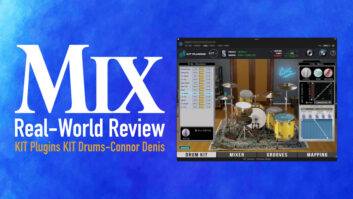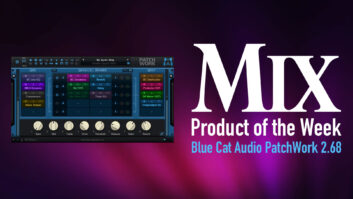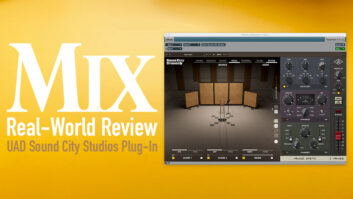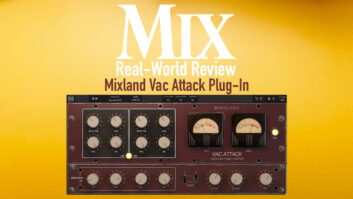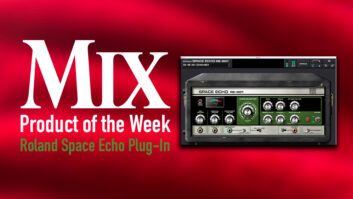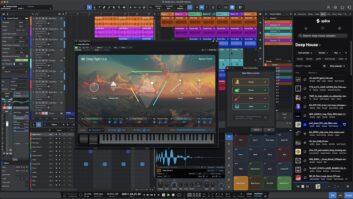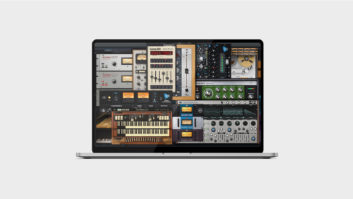Today, there seem to be as many virtual instrument plug-ins as there are guitars, synths, vocoders, basses, string sections and electric pianos to emulate. Need a classic synth or a keyboard for a session but can’t afford the vintage price or drifting oscillators? Just pull one down with the mouse. If that’s not enough polyphony for the job, you can pull down as many as your CPU can support.
Keeping track of new plug-ins can be a full-time job. Dozens of manufacturers now offer hundreds of plug-ins that can produce thousands of effects, from relatively straightforward EQ and dynamic control to massively complex reverb algorithms and multidimensional spatial manipulations. Mix‘s last two plug-in roundups (see the November 2001 and September 2002 issues) were pretty comprehensive, but for this survey, which concentrates on “virtual instruments,” we found another 52 new or significantly upgraded products that were introduced in 2002.
Access Music (www.access-music.de; www.digidesign.com) released the new Virus Indigo TDM Synthesizer Plug-In, priced at $795. (Registered Mac and PC Virus TDM users can upgrade for $95.) Virus Indigo’s parameters can be manipulated via the GUI, Digidesign’s Pro Control and Control|24 control surfaces via Ethernet, or with a hardware synthesizer controller. Taking advantage of the higher resolution and increased voice count of Digidesign’s Pro Tools|HD workstations, Virus Indigo TDM replicates the award-winning sounds of the Virus hardware synthesizer family with four oscillators per voice and 20 available voices, dual six-pole filters and up to eight multitimbral parts per DSP.
If you’re better at humming a melody than playing it on a synth, check out Antares Audio Technologies‘ (www.antarestech.com) kantos 1.0 Audio-Controlled Synthesizer ($299; DirectX, MAS, VST, RTAS). Controlled by any pitched monophonic audio signal, such as a voice or a trumpet, the dual-platform kantos analyzes incoming audio and instantaneously extracts pitch, dynamics, harmonic content and formant characteristics from the information to control the kantos sound engine. This unique plug-in’s harmonic resynthesis capabilities can impose the melodic gestures and the actual lyrics of a song onto the synthesized sound. Included are dual wavetable oscillators with pitch constraint and quantization controls; three resonant multimode filters; two envelope generators and LFOs; and kantos’ one-of-a-kind Timbral Articulator module, which takes the harmonic content and formant information from an input signal and dynamically applies it to the synthesized signal to produce traditional — and not so traditional — wavetables. Additional wavetables will be made available for download from the Antares Website, and custom wavetables can be created with pretty much any audio or sample editor.
Remember that beat-up ’73 Fender Rhodes the roadie spilled beer on during a soundcheck at The Fillmore? Applied Acoustics Systems (www.applied-acoustics.com) has modeled it and dozens of other vintage electric pianos in Lounge Lizard EP-1 ($199; PC/Mac, VST, DXi, MAS, DirectConnect). Working both as a plug-in and stand-alone, the Lizard is laid out like a hardware desktop beat box with rotary virtual knobs for controls over mallet stiffness and force, tine decay and tone, and pickup position symmetry and distance. If that’s not enough to faithfully model that trusted beer-soaked Rhodes, the engineers at Applied Acoustics Systems included a way for users to change the material used for the hammers, as well. Lounge Lizard works on Windows 95/98/2000/XP and Macintosh 9.2 systems and above.
Arturia‘s (www.arturia.com; www.thinkware.com) Storm 2.0 release added support for Mac OS X and Windows XP operating systems, online collaboration and file sharing, and a new software synth to this impressive set of easy-to-use music and recording tools. The Storm Music Studio now comes with 13 virtual instruments and also includes the new Shadow virtual analog polyphonic synth. Based on subtractive synthesis, the VST Instrument plug-in Shadow emulates the sounds of famous hardware synthesizers made in the ’80s without sampling and continuous switching between the waveforms without aliasing. Eight-note polyphony, two oscillators, a noise generator, and a multimode filter with highpass, lowpass, bandpass, notch, bell (12 dB/octave two-pole) and hyper-resonant analog filters (24 dB/octave, four-pole) are included with Shadow. Two programming modes are provided: 100% manual or assisted for automatic note correction. And, like other Storm modules, Shadow can be played as a VST Instrument through the Storm Studio (within Cubase VST and Logic Audio).
Announced last year, Universal Sound Bank’s hybrid UVI (Universal Virtual Instrument) plug-in format for VST, MAS and RTAS users has since been well supported by other plug-in manufacturers. Big Fish Audio (www.bigfishaudio.com; www.plugsound.com) added four of its USB Plugsound volumes to the growing list: Keyboards Collection, World of Synthesizers, Drums & Percussion, and Hip Hop and R&B Toolkit ($99/each; Mac/PC). Large sound libraries come with each volume, and, most important, MIDI provides access to the sounds, which can be played and modified within your digital audio workstation’s GUI. Keyboards Collection offers 256 presets and over 3,000 samples of acoustic and electric pianos, clavinets and organs. Acoustic pianos in classical, jazz and pop styles and a best-of selection of famous electric pianos from the past are well represented. A new Release Trigger feature makes for more convincing recreations of harpsichords, and users can now control every UVI knob and slider via MIDI. World of Synthesizers offers a variety of analog, digital, virtual analog and plug-in synthesizer sounds, and Plugsound Volume 3 Drums & Percussion brings a host of acoustic and electronic drum kits to the desktop with more than 60 percussion instruments such as congas, djembe, bongos, darbukas, Brazilian berimbaus and more. Finally, Hip Hop and R&B Toolkit offers 647 presets using more than 1,500 samples. This collection of loops, kits and multisampled instruments was initiated by longtime R&B programmers.
Adding to the company’s AS-1 and DS-1 line, BitHeadz (www.bitheadz.com) beefed up with Unity Session Digital Studio ($649; Mac MAS, VST, RTAS, DirectConnect, Pro Tools|HD) this past year. Releasing six content titles for the Unity and Phrazer platforms, BitHeadz now gives Unity Session up to 256-note polyphony and FreeMIDI, PC300, OMS and OS X support. Users can assign two MIDI and two audio effects per channel in session and assign two send effects and two global effects on master outputs. A built-in sample editor includes a Stereo Record function with gain and DSP function controls. The Unity Session synthesis engine includes three stereo oscillators and two stereo filters per voice and an 8-octave range per oscillator. Users can play samplers, synthesizers and physically modeled synths at the same time. File support includes 24-bit GigaSampler, Retro AS-1, Unity DS-1, Sound Designer, .AIFF, SampleCell II, DLS, SoundFont 2.0 and .WAV; and included content with Unity Session Digital Studio are Black & Whites, Pop Drums, Orchestral Strings and a large number of factory AS-1 and DS-1 programs.
Cakewalk (www.cakewalk.com) is now distributing DXi software synthesizers from rgcAudio. Triangle II DXi (free) is a sequel to the company’s monophonic Triangle synth, but the real news is rcgAudio Pentagon I ($99; PC VST 2.0), which runs natively under Cakewalk’s Sonar platform. With the Pentagon’s facade offering one of the more serious banks of control knobs in town, it’s no wonder that rcgAudio and Cakewalk target this for synth players and sound designers. Four fat oscillators, 13 alias-free waveforms and a noise generator per oscillator make shaping just about any sound possible, and the Pentagon’s user-loadable waveform slots operate in both simple cycle and full-range modes. Over 50 synthetic and vintage wavetables are included, as are 64-voice polyphony with polyphony limiter and intelligent voice allocation. The Pentagon’s built-in effects section includes four filter level effects, six modulation effects and an amp/cabinet simulator with 19 configurations modeled. Pentagon I DXi now offers full MIDI automation support, as well.
If you’ve ever built a synthesizer or dreamed of doing so, CreamWare‘s (www.creamware.com) Modular III Modular Synthesizer System ($249; PC/Mac) lets you do it virtually. Offering all of the company’s Modular Synthesizer V2’s features, Modular III goes on to include more than 70 new modules, 25 ready-to-use synthesizer patches and the new Modular Remote Control, which allows even novice synth programmers to use and edit even the most complex modular synth patches with a simplified control knob interface. Anywhere from four to 16 freely selectable patch parameters can be controlled remotely from the MRC window, and users can import any graphic file in the bitmap (BMP) format to create custom skins. The newly added modules bring the Modular platform to a whopping 220 and include new drum, mix and gain, filter, OSC, sampler, sequencer and effect modules such as 48dB high/lowpass filter, quad crossfade, vocoder synthesis and unipolar to bipolar. Built to Hollywood movie composer Hans Zimmer’s specifications, Modular III requires CreamWare’s Luna II, PowerSampler II, Pulsar II, PowerPulsar or SCOPE/SP. Also new from CreamWare is Minimax ($245), a complete emulation of the legendary Minimoog. The company claims that its software emulation achieves a 1:1 ratio in emulating the Minimoog’s sonic characteristics.
Cycling ’74‘s (www.cycling74.com; www.pluggo.com) Pluggo 3 ($199 Mac; $59 upgrade) is out, and included with it now are 19 Essential Instruments, some designed by eowave, makers of iSynth (distributed by Cycling ’74.) Several components from the latter soft-synth system (see September 2002 Mix) that are now included with Pluggo 3 take full advantage of the company’s new and improved Max4/MSP2 audio-programming environment. Additive synths; analog-modeling drum and percussion synths; sampling, granular, FM and wavetable synthesis; and wave-shaping tools are included, such as Flying Waves (virtual Theremin), Analog Percussion, Additive Heaven and Harmonic Dreamz. The latter is an additive synth that exposes the first 16 partials of a primary tone and includes a random detuner, a tremolo system (with both LFO and audio-rate oscillation) and an amplitude envelope for sound shaping. Pluggo 3 supports RTAS, MAS and VST plug-in formats.
Edirol (www.edirol.com) followed its HyperCanvas, Super Quartet and Virtual Sound Canvas plug-in family releases with HQ-OR Orchestral ($385; PC/Mac, VST, DXi). Like working with any easy-to-use general MIDI module, Orchestral provides screens to adjust chorus, select sounds and pan instruments with a nifty visual pan display. Premium acoustic sounds in this package put the focus on strings, woodwinds, brass, percussion and keyboards and includes Cakewalk’s Music Creator 2002 software. Sixteen-part, 128-voice polyphony and up to 24-bit/96kHz compatibility are offered in addition to over 350 preset and user patches and 39 drum kits. Samples include realistic articulations such as vibrato, spiccato, pizzicato and tremolo.
Emagic (www.emagic.de), now owned by Apple Computer, added the EVB3 (B3 emulations) and EVD6 (clavinets D6) plug-ins early last year to the company’s growing list of soft instruments and now releases two more. The ES2 Emagic Synthesizer ($247) adds even more punch to its predecessor, the ES1, with up to 32 voices per instantiation, intelligent, random sound programming with adjustable intensity and destination, and built-in modulation and distortion effects. Three oscillators per voice and 100 digital waveforms plus noise round out the ES2’s sound-shaping tools, as do dynamic wavetable scanning via freely selectable modulation sources. Emagic’s EXS24 mk II ($499) now supports VST 2.0, offers 32-bit processing and reads its native sample format and SoundFont2 and Akai S1000-3000 files. Improvements on the original EXS24 include a better-sounding multimode filter, three LFOs, a new user interface and a completely flexible modulation system that can route from any source (including sidechain level) to any target. The EXS24 mk II is a free update for existing EXS24 users and, like ES2, supports Mac OS 9.x and OS X and Windows 98SE/ME/2000/XP.
There are three new virtual instrument offerings from Ilio Entertainments (www.ilio.com) to choose from since Mix‘s last plug-in guide. The company’s Spectrasonics Stylus Vinyl Groove Module ($299; MAS, RTAS and VST Mac/PC versions included) integrates a 3GB library of groove elements, loops and samples to the easy-to-use Plugsound interface. Over a thousand turntable tricks, skips, stops, beat juggling and scratch FX are included, as are percussion loops and over 3,000 kicks, snares, hi-hats and a built-in patch-management system to quickly find it all. R&B, two-step, trip-hop, chemical, downtempo dub and many other styles are represented in Stylus, and each Groove Control groove allows users to independently change its pitch, tempo, feel and pattern without using up DSP power. The Atmosphere Dream Synth Module ($399), designed by synthesist/sound designer/former Roland product developer Eric Persing, offers dynamic layering of sounds and total recall within Logic, Cubase, Digital Performer, Pro Tools, Fruity Loops and other VST-host applications. Engineered to create lush, evolving pads and textural ambient sounds, Atmosphere’s multimode resonant filters per layer and master filters round out this soft-synth dream.
Also new from Ilio on the Plugsound platform is the Trilogy Total Bass Module ($399), with over 1,000 new dual-layered acoustic, electric and synth bass sounds. Achieving “cone-blowing subsonic sound,” the Trilogy features eight-way velocity switching and the company’s “True Staccato” sample-mapping feature for realistic repeated notes. Minimoog-style legato triggering and a built-in patch-management system are included, as well.
LinPlug Virtual Instruments (www.linplug.com) recently released Element P Percussion Synthesizer ($39; VST) and Delta III Matrix Synthesizer ($99; VST). The 32-voice Element P offers 172 virtual analog percussion synth sounds, eight-part multitimbral operation, 32-voice polyphony, six separate outputs and a simple interface to quickly create a broad variety of electronic drum and bass sounds. The Element’s parameters can be controlled via MIDI, and full Doepfer Alpha-Dial support is included. The extendable design of LinPlug’s Delta III synth currently offers three oscillators and filters, dual-envelope modules, four effect modules and is also eight-part multitimbral, each part with its own stereo output. Twenty-three filters are included, and fully recognized velocity, mono and poly aftertouch, pitch bend and mod-wheel control are supported. The full version of Delta III comes with 472 presets, and a PC or Mac LinPlug Alpha Classic Synthesizer is also included.
The McDSP (www.mcdsp.com) Synthesizer One ($695; TDM Mac), the company’s fifth TDM plug-in, is a potent modular wavetable, multimode soft synthesizer with sophisticated wave-editing capabilities. Wavetable, FM, AM, ring modulation, additive and subtractive synthesis methods are offered, and external audio can be processed and combined with synthesized sounds. Oscillator, filter, LFO and envelope signals can be routed to multiple modulation targets within Synth One, and wavetable data can be used in oscillators and LFOs or created from a suite of editing tools. ProTools|HD and Mix TDM systems are supported, as are pre-USB Macs with OS 9.0 or later.
Like LinPlug, MHC Synthesizers & Effects (www.mhc.se) is proving that $39 buys plenty of synthesizing power these days with Mikael Hillborg’s new Voxynth and Fatsondo ($39 bundled together; VST PC/Mac). Voxynth, great to create vocal sounds or synthetic choirs, has three oscillators per voice, pitch modulation and a stereo delay, as well as a multimode formant filter to modulate via envelope or using Voxynth’s performance keys. Whereas its brother Fatsondo has built-in formant filters, Voxynth offers 20 different formant filter types that are swept by the envelope or performance keys to morph between different sounds. Traditional “e”, “a” and “u” formant vowels are included, as are ones that don’t exist but have a vocal character and can be used to create interesting timbres. Fatsondo synthesizer is designed specifically to create — you guessed it — fat sounds. Built-in chorus, flanger and stereo delay, a polyphonic unison mode, three oscillators per voice and a resonant lowpass/highpass filter fatten up any track, but Fatsondo’s polyphonic unison mode goes even further by creating as many as six or nine oscillators per voice.
Native Instruments (www.native-instruments.com) has added Pro-53 ($199; Mac/PC DirectConnect, VST, MAS, DXi) and Reaktor Session ($349) to the company’s existing lineup of software instruments, which already includes Spektral Delay PTE, Kontakt, FM7, B4 and Pro-52. The latter’s Pro-53 offspring, which, like other NI instruments, can also operate in stand-alone mode, is a major upgrade to this virtual Sequential Circuits Prophet-5 representation with several new functions and improvements. A new oscillator technology provides a noticeably more brilliant, warmer sound than the 52, and a new highpass filter mode, MIDI Learn function, invertable filter envelopes and an LFO/envelope/retrigger options add to the sound-programming mix. The Pro-53 comes with an optimized graphical interface, and 64 new sounds — programmed by synthesist John Bowen — take full advantage of these extended functions. Also new from Native is Reaktor Session, an ambitious platform that can incorporate a wide range of soft synths, samplers, resynthesizers, beat loopers, groove/drum machines, surround effects, and pattern and control sequencers powered by the Reaktor engine. Users can design their own studio from pre-built instruments, and multiple instruments are easily connected together in Reaktor session, allowing even the most complex Reaktor sessions to appear as a single plug-in in VST and Dxi host applications. As a stand-alone application, Reaktor Session supports ASIO, DirectConnect, DXi, VST 2.0, OMS and MAS on Windows 98/ME/2000/XP and Mac OS 8.6 or higher.
New to the Reason 2.0 Mac/PC platform from Propellerhead Software (www.propellerheads.se; www.m-audio.com) are two new virtual instruments included with this all-in-one application. Malström Graintable Synthesizer is a proprietary synth from Propellerheads that combines granular synthesis with wavetable synthesis. Users can evolve through a sound by controlling the movement with real-time controllers, velocity- and modulation-performance information and the spectral harmonics of this instrument’s graintable. Both of Malström’s filters have five modes including 12 dB/octave, lowpass, bandpass, subtractive and additive comb filtering, and a shared filter envelope is also included to control either or both of the filter sections simultaneously. Dual modulators and LFOs with a wide variety of curves are available, and, when used in One-Shot mode, Malström can be synched to incoming tempo. Also included with Reason 2.0 is NN-XT, an advanced sampler featuring alternating sample playback and auto-pitch detection, Mac OSX support, a detachable sequencer and 32-bit sample support.
Serato Audio Research‘s (www.serato.com) Scratch Studio Edition ($299; PC/Mac RTAS, HTDM, MAS) employs a physical “virtual” vinyl LP that connects via USB, allowing turntablists to scratch any digital sample or sound file. The included vinyl controller device contains a control signal that allows the computer to track record position, motion and direction of the needle, and simulate the same movement within a sound file. Scratch Live ($599, Mac/PC stand-alone) allows turntablists to transfer their valuable vinyl to hard drive and control the .WAV, .AIFF and MP3 files in live performance.
Software Technology‘s (www.software-technology.com) VAZ Modular has a new stable mate in the form of VAZ 2010 ($179; PC, VST, DXi). Used in stand-alone mode, VAZ 2010 can also host other DXi and VST plug-in instruments. Each of VAZ 2010’s 16 analog synthesizers include sample-playback facilities, 16 polyphonic sequencers and a 16-channel mixer. A nifty QWERTY keyboard allows auditioning of sounds when no external MIDI keyboard is around, and the 2010’s three oscillators per voice, switchable audio range, ring modulation, noise generator and eight filter modes make full use of Software Technology’s new Intelligent Processing System to reduce CPU drain by as much as 50%. VAZ 2010 supports MME, DirectX and ASIO and multiple soundcard outputs.
Bi-platform soft synthesists who miss their old Minimoogs will appreciate the new Tsunami ($69) from Sonic Reef (www.sonicreef.com). This three-oscillator VST Instrument for Mac and Windows, which also works as a stand-alone synth, pays faithful tribute to the legend’s front panel. Sixty-four-note polyphony, dual-ADSR envelope generators, a 24dB resonant lowpass filter and a noise generator are standard equipment, and although Tsunami is not multitimbral, users can load as many multiple instances of the synth as the CPU can handle. Tsunami needs a minimum Pentium II/266 with Windows 98 or an Apple G3/233 running OS 8.0 or later.
Steinberg Media Technologies (www.steinberg.net) has added two new virtual instruments and a virtual instrument “rack” to its lineup. New to the Virtual Guitarist family is Virtual Guitarist Electric Edition ($249; PC/Mac, VST), essentially an electric rhythm guitarist and virtual effects pedal board. Electric Edition is based on samples recorded by German session guitarist Thomas Blug and the playing styles of 30 different players from the ’50s to the present. Just choose a player, select the chords, and Electric Edition creates real guitar tracks and offers countless variations based on user-selected syncopation, shuffle, dynamics, track doubling, phrasing and chord extensions. Electric Edition’s virtual pedal board can also be accessed as a separate plug-in.
PLEX ($249) is a new instrument designed by PPG synth legend Wolfgang Palm in cooperation with Steinberg. Featuring a new intelligent synthesizing process, PLEX allows the organic combining of disparate sounds and the ability to analyze and split an original sound into individually controllable lower and higher spectra, filter characteristic and amplitude envelope segments. Each segment can be replaced and combined with components from other original sounds, allowing users to replace the lower-spectrum “base” component of a trombone sound, for example, with the base component of a sitar sample, each retaining independently controllable amplitude envelope and filter characteristics. Three hundred presets and 97 specially analyzed acoustic and synthetic sound sources are included. Also new from Steinberg is V-STACK ($49), a Virtual Instrument Rack for VST System Link. Up to 16 VST and DXi instruments can be loaded to turn a PC into a virtual instrument station, which can also be played live without a host application.
D-coder ($249; PC/Mac, VST, MAS) from TC Works (www.tcworks.de) integrates a synth engine as tone generator into this advanced vocoder plug-in, therefore not requiring an external carrier signal to make the vocoding effect audible. Running on any Mac or PC equipped with PowerCore, D-coder is based on DSP technology used in all of Waldorf synthesizers, now accessible from inside any VST- or MAS-compatible sequencer. An integrated chorus unit fattens things up, and a 3-band EQ section allows users to emphasize critical-speech frequencies. Playable from a MIDI track or in real time from a keyboard, D-coder’s synthesizer section can be played independent of the vocoder, and all LFOs can follow MIDI sync within any VST 2.0-compatible sequencer to independently modulate the synth and the vocoder in musically relevant values. The 100-band D-coder offers dual oscillators with ring modulation, high-resolution analysis and vocoder channel meters, and it can be played in “free run” mode without MIDI.
Randy Alberts (www.opendooredit.com) is a California-based audio and music journalist. His book, Tascam: 30 Years of Recording Evolution, has recently been published.
